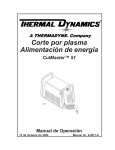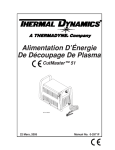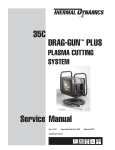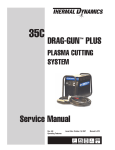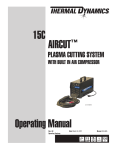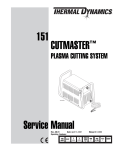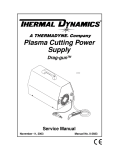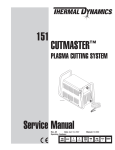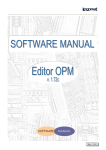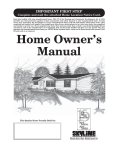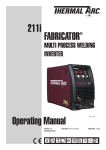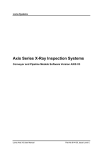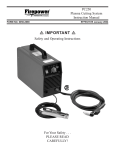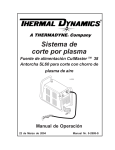Download Thermal Dynamics CutMaster 51 Operating
Transcript
51 CUTMASTER ™ PLASMA CUTTING SYSTEM Art # A-04611 Operating Manual Rev. AA.01 Date: October 20, 2006 Operating Features: Manual # 0-2971 WE APPRECIATE YOUR BUSINESS! Congratulations on your new Thermal Dynamics product. We are proud to have you as our customer and will strive to provide you with the best service and reliability in the industry. This product is backed by our extensive warranty and world-wide service network. To locate your nearest distributor or service agency call 1-800426-1888, or visit us on the web at www.thermal-dynamics.com. This Operating Manual has been designed to instruct you on the correct use and operation of your Thermal Dynamics product. Your satisfaction with this product and its safe operation is our ultimate concern. Therefore please take the time to read the entire manual, especially the Safety Precautions. They will help you to avoid potential hazards that may exist when working with this product. YOU ARE IN GOOD COMPANY! The Brand of Choice for Contractors and Fabricators Worldwide. Thermal Dynamics is a Global Brand of manual and automation Plasma Cutting Products for Thermadyne Industries Inc. We distinguish ourselves from our competition through marketleading, dependable products that have stood the test of time. We pride ourselves on technical innovation, competitive prices, excellent delivery, superior customer service and technical support, together with excellence in sales and marketing expertise. Above all, we are committed to developing technologically advanced products to achieve a safer working environment within the welding industry. WARNINGS Read and understand this entire Manual and your employer’s safety practices before installing, operating, or servicing the equipment. While the information contained in this Manual represents the Manufacturer's best judgement, the Manufacturer assumes no liability for its use. Plasma Cutting Power Supply CutMaster™ 51 Operating Manual Number 0-2971 Covered under U.S. Patents. Published by: Thermal Dynamics Corporation 82 Benning Street West Lebanon, New Hampshire, USA 03784 (603) 298-5711 www.thermal-dynamics.com Copyright 2003, 2004, 2005, 2006 by Thermal Dynamics Corporation All rights reserved. Reproduction of this work, in whole or in part, without written permission of the publisher is prohibited. The publisher does not assume and hereby disclaims any liability to any party for any loss or damage caused by any error or omission in this Manual, whether such error results from negligence, accident, or any other cause. Printed in the United States of America Publication Date: October 20, 2006 Record the following information for Warranty purposes: Where Purchased:____________________________________ Purchase Date:_______________________________________ Power Supply Serial #:________________________________ Torch Serial #:________________________________________ TABLE OF CONTENTS SECTION 1: GENERAL INFORMATION ................................................................................................ 1-1 1.01 1.02 1.03 1.04 1.05 Notes, Cautions and Warnings ...................................................................... Important Safety Precautions ....................................................................... Publications .................................................................................................. Declaration of Conformity ............................................................................. Statement of Warranty .................................................................................. 1-1 1-1 1-2 1-4 1-5 SECTION 2: INTRODUCTION ............................................................................................................... 2-1 2.01 2.02 2.03 2.04 2.05 Scope of Manual .......................................................................................... Power Supply Specifications ......................................................................... Input Wiring Specifications ........................................................................... Power Supply Features ................................................................................. Power Supply Options and Accessories ....................................................... 2-1 2-1 2-2 2-3 2-4 SECTION 3: INSTALLATION .................................................................................................................. 3-1 3.01 3.02 3.03 3.04 3.05 Unpacking .................................................................................................... Lifting Options .............................................................................................. Primary Input Power Connections ................................................................. Gas Connections .......................................................................................... Torch Connections ........................................................................................ 3-1 3-1 3-2 3-4 3-8 SECTION 4: OPERATION ...................................................................................................................... 4-1 4.01 Front Panel Controls and Indicators .............................................................. 4-1 4.02 Preparations for Operation ............................................................................ 4-2 SECTION 5: SERVICE .......................................................................................................................... 5-1 5.01 5.02 5.03 5.04 General Maintenance .................................................................................... 5-1 Common Faults ............................................................................................ 5-5 Basic Troubleshooting Guide ......................................................................... 5-6 Power Supply Basic Parts Replacement ...................................................... 5-11 TABLE OF CONTENTS (continued) SECTION 6: PARTS LISTS ................................................................................................................... 6-1 6.01 6.02 6.03 6.04 6.05 6.06 Introduction ................................................................................................... Ordering Information ..................................................................................... Power Supply Replacement .......................................................................... Replacement Parts ....................................................................................... Options and Accessories .............................................................................. Torch Parts ................................................................................................... 6-1 6-1 6-1 6-2 6-2 6-3 PATENT INFORMATION ............................................................................................................ 6-4 APPENDIX 1: SEQUENCE OF OPERATION (BLOCK DIAGRAM) .......................................................................................................... A-1 APPENDIX 2: DATA TAG INFORMATION .................................................................................. A-2 APPENDIX 3: MAINTENANCE SCHEDULE ............................................................................. A-3 APPENDIX 4: TORCH PIN - OUT DIAGRAMS .......................................................................... A-4 APPENDIX 5: TORCH CONNECTION DIAGRAMS ................................................................... A-5 APPENDIX 6: SYSTEM SCHEMATIC, 208/230V UNITS .......................................................... A-6 APPENDIX 7: SYSTEM SCHEMATIC, 400V & 460V UNITS ................................................... A-8 APPENDIX 8: Publication History ........................................................................................... A-10 Global Customer Service Contact Information ..................................................... Inside Rear Cover SECTION 1: GENERAL INFORMATION 1.01 Notes, Cautions and Warnings GASES AND FUMES Gases and fumes produced during the plasma cutting process can be dangerous and hazardous to your health. • Keep all fumes and gases from the breathing area. Keep your head out of the welding fume plume. Throughout this manual, notes, cautions, and warnings are used to highlight important information. These highlights are categorized as follows: • Use an air-supplied respirator if ventilation is not adequate to remove all fumes and gases. NOTE • The kinds of fumes and gases from the plasma arc depend on the kind of metal being used, coatings on the metal, and the different processes. You must be very careful when cutting or welding any metals which may contain one or more of the following: An operation, procedure, or background information which requires additional emphasis or is helpful in efficient operation of the system. CAUTION Antimony Arsenic Barium Beryllium Cadmium A procedure which, if not properly followed, may cause damage to the equipment. Chromium Cobalt Copper Lead Manganese Mercury Nickel Selenium Silver Vanadium • Always read the Material Safety Data Sheets (MSDS) that should be supplied with the material you are using. These MSDSs will give you the information regarding the kind and amount of fumes and gases that may be dangerous to your health. WARNING A procedure which, if not properly followed, may cause injury to the operator or others in the operating area. • For information on how to test for fumes and gases in your workplace, refer to item 1 in Subsection 1.03, Publications in this manual. 1.02 Important Safety Precautions • Use special equipment, such as water or down draft cutting tables, to capture fumes and gases. WARNINGS • Do not use the plasma torch in an area where combustible or explosive gases or materials are located. • Phosgene, a toxic gas, is generated from the vapors of chlorinated solvents and cleansers. Remove all sources of these vapors. OPERATION AND MAINTENANCE OF PLASMA ARC EQUIPMENT CAN BE DANGEROUS AND HAZARDOUS TO YOUR HEALTH. Plasma arc cutting produces intense electric and magnetic emissions that may interfere with the proper function of cardiac pacemakers, hearing aids, or other electronic health equipment. Persons who work near plasma arc cutting applications should consult their medical health professional and the manufacturer of the health equipment to determine whether a hazard exists. To prevent possible injury, read, understand and follow all warnings, safety precautions and instructions before using the equipment. Call 1-603-2985711 or your local distributor if you have any questions. Manual 0-2971 • This product, when used for welding or cutting, produces fumes or gases which contain chemicals known to the State of California to cause birth defects and, in some cases, cancer. (California Health & Safety Code Sec. 25249.5 et seq.) ELECTRIC SHOCK Electric Shock can injure or kill. The plasma arc process uses and produces high voltage electrical energy. This electric energy can cause severe or fatal shock to the operator or others in the workplace. • Never touch any parts that are electrically “live” or “hot.” 1-1 GENERAL INFORMATION • Wear dry gloves and clothing. Insulate yourself from the work piece or other parts of the welding circuit. • Repair or replace all worn or damaged parts. • Extra care must be taken when the workplace is moist or damp. • Install and maintain equipment according to NEC code, refer to item 9 in Subsection 1.03, Publications. PLASMA ARC RAYS Plasma Arc Rays can injure your eyes and burn your skin. The plasma arc process produces very bright ultra violet and infra red light. These arc rays will damage your eyes and burn your skin if you are not properly protected. • Disconnect power source before performing any service or repairs. • To protect your eyes, always wear a welding helmet or shield. Also always wear safety glasses with side shields, goggles or other protective eye wear. • Read and follow all the instructions in the Operating Manual. • Wear welding gloves and suitable clothing to protect your skin from the arc rays and sparks. • Keep helmet and safety glasses in good condition. Replace lenses when cracked, chipped or dirty. FIRE AND EXPLOSION • Protect others in the work area from the arc rays. Use protective booths, screens or shields. Fire and explosion can be caused by hot slag, sparks, or the plasma arc. • Use the shade of lens as suggested in the following per ANSI/ASC Z49.1: • Be sure there is no combustible or flammable material in the workplace. Any material that cannot be removed must be protected. • Ventilate all flammable or explosive vapors from the workplace. • Do not cut or weld on containers that may have held combustibles. NOISE Noise can cause permanent hearing loss. Plasma arc processes can cause noise levels to exceed safe limits. You must protect your ears from loud noise to prevent permanent loss of hearing. • To protect your hearing from loud noise, wear protective ear plugs and/or ear muffs. Protect others in the workplace. • Noise levels should be measured to be sure the decibels (sound) do not exceed safe levels. • For information on how to test for noise, see item 1 in Subsection 1.03, Publications, in this manual. GENERAL INFORMATION Minimum Protective Shade No. Suggested Shade No. Less Than 300* 8 9 300 - 400* 9 12 400 - 800* 10 14 * These values apply where the actual arc is clearly seen. Experience has shown that lighter filters may be used when the arc is hidden by the workpiece. • Provide a fire watch when working in an area where fire hazards may exist. • Hydrogen gas may be formed and trapped under aluminum workpieces when they are cut underwater or while using a water table. DO NOT cut aluminum alloys underwater or on a water table unless the hydrogen gas can be eliminated or dissipated. Trapped hydrogen gas that is ignited will cause an explosion. Arc Current 1.03 Publications Refer to the following standards or their latest revisions for more information: 1. OSHA, SAFETY AND HEALTH STANDARDS, 29CFR 1910, obtainable from the Superintendent of Documents, U.S. Government Printing Office, Washington, D.C. 20402 2. ANSI Standard Z49.1, SAFETY IN WELDING AND CUTTING, obtainable from the American Welding Society, 550 N.W. LeJeune Rd, Miami, FL 33126 3. NIOSH, SAFETY AND HEALTH IN ARC WELDING AND GAS WELDING AND CUTTING, obtainable from the Superintendent of Documents, U.S. Government Printing Office, Washington, D.C. 20402 4. ANSI Standard Z87.1, SAFE PRACTICES FOR OCCUPATION AND EDUCATIONAL EYE AND FACE PROTECTION, obtainable from American National Standards Institute, 1430 Broadway, New York, NY 10018 5. ANSI Standard Z41.1, STANDARD FOR MEN’S SAFETY-TOE FOOTWEAR, obtainable from the American National Standards Institute, 1430 Broadway, New York, NY 10018 1-2 Manual 0-2971 6. ANSI Standard Z49.2, FIRE PREVENTION IN THE USE OF CUTTING AND WELDING PROCESSES, obtainable from American National Standards Institute, 1430 Broadway, New York, NY 10018 7. AWS Standard A6.0, WELDING AND CUTTING CONTAINERS WHICH HAVE HELD COMBUSTIBLES, obtainable from American Welding Society, 550 N.W. LeJeune Rd, Miami, FL 33126 8. NFPA Standard 51, OXYGEN-FUEL GAS SYSTEMS FOR WELDING, CUTTING AND ALLIED PROCESSES, obtainable from the National Fire Protection Association, Batterymarch Park, Quincy, MA 02269 9. NFPA Standard 70, NATIONAL ELECTRICAL CODE, obtainable from the National Fire Protection Association, Batterymarch Park, Quincy, MA 02269 10. NFPA Standard 51B, CUTTING AND WELDING PROCESSES, obtainable from the National Fire Protection Association, Batterymarch Park, Quincy, MA 02269 11. CGA Pamphlet P-1, SAFE HANDLING OF COMPRESSED GASES IN CYLINDERS, obtainable from the Compressed Gas Association, 1235 Jefferson Davis Highway, Suite 501, Arlington, VA 22202 12. CSA Standard W117.2, CODE FOR SAFETY IN WELDING AND CUTTING, obtainable from the Canadian Standards Association, Standards Sales, 178 Rexdale Boulevard, Rexdale, Ontario, Canada M9W 1R3 13. NWSA booklet, WELDING SAFETY BIBLIOGRAPHY obtainable from the National Welding Supply Association, 1900 Arch Street, Philadelphia, PA 19103 14. American Welding Society Standard AWSF4.1, RECOMMENDED SAFE PRACTICES FOR THE PREPARATION FOR WELDING AND CUTTING OF CONTAINERS AND PIPING THAT HAVE HELD HAZARDOUS SUBSTANCES, obtainable from the American Welding Society, 550 N.W. LeJeune Rd, Miami, FL 33126 15. ANSI Standard Z88.2, PRACTICE FOR RESPIRATORY PROTECTION, obtainable from American National Standards Institute, 1430 Broadway, New York, NY 10018 Manual 0-2971 1-3 GENERAL INFORMATION 1.04 Declaration of Conformity Manufacturer: Thermal Dynamics Corporation Address: 82 Benning Street West Lebanon, New Hampshire 03784 USA The equipment described in this manual conforms to all applicable aspects and regulations of the ‘Low Voltage Directive’ (European Council Directive 73/23/EEC as amended by Council Directive 93/68/EEC) and to the National legislation for the enforcement of this Directive. Serial numbers are unique with each individual piece of equipment and details description, parts used to manufacture a unit and date of manufacture. National Standard and Technical Specifications The product is designed and manufactured to a number of standards and technical requirements. Among them are: * CSA (Canadian Standards Association) standard C22.2 number 60 for Arc welding equipment. * UL (Underwriters Laboratory) rating 94VO flammability testing for all printed-circuit boards used. * ISO/IEC 60974-1 (BS 638-PT10) (EN 60 974-1) (EN50192) (EN50078) applicable to plasma cutting equipment and associated accessories. * Extensive product design verification is conducted at the manufacturing facility as part of the routine design and manufacturing process. This is to ensure the product is safe, when used according to instructions in this manual and related industry standards, and performs as specified. Rigorous testing is incorporated into the manufacturing process to ensure the manufactured product meets or exceeds all design specifications. Thermal Dynamics has been manufacturing products for more than 30 years, and will continue to achieve excellence in our area of manufacture. Manufacturers responsible representative: GENERAL INFORMATION Giorgio Bassi Managing Director Thermal Dynamics Europe Via rio Fabbiani 8A 40067 Rastignano (BO) Italy 1-4 Manual 0-2971 1.05 Statement of Warranty LIMITED WARRANTY: Subject to the terms and conditions established below, Thermal Dynamics® Corporation warrants to the original retail purchaser that new Thermal Dynamics CUTMASTER™ 1Series plasma cutting systems sold after the effective date of this warranty are free of defects in material and workmanship. Should any failure to conform to this warranty appear within the applicable period stated below, Thermal Dynamics Corporation shall, upon notification thereof and substantiation that the product has been stored operated and maintained in accordance with Thermal Dynamics’ specifications, instructions, recommendations and recognized industry practice, correct such defects by suitable repair or replacement. This warranty is exclusive and in lieu of any warranty of merchantability or fitness for a particular purpose. Thermal Dynamics will repair or replace, at its discretion, any warranted parts or components that fail due to defects in material or workmanship within the time periods set out below. Thermal Dynamics Corporation must be notified within 30 days of any failure, at which time Thermal Dynamics Corporation will provide instructions on the warranty procedures to be implemented. Thermal Dynamics Corporation will honor warranty claims submitted within the warranty periods listed below. All warranty periods begin on the date of sale of the product to the original retail customer or 1 year after sale to an authorized Thermal Dynamics Distributor. LIMITED WARRANTY PERIOD Product CUTMASTER™ CUTMASTER™ CUTMASTER™ CUTMASTER™ 38 51 81 101 Power Supply Components (Parts and Labor) 3 Years 3 Years 3 Years 3 Years Torch and Leads (Parts and Labor) 1 Year 1 Year 1 Year 1 Year This warranty does not apply to: 1. Consumable Parts, such as tips, electrodes, shield cups, o - rings, starter cartridges, gas distributors, fuses, filters. 2. Equipment that has been modified by an unauthorized party, improperly installed, improperly operated or misused industry standards. basedupon In the event of a claim under this warranty, the remedies shall be, at the discretion of Thermal Dynamics Corporation: 1. Repair of the defective product. 2. Replacement of the defective product. 3. Reimbursement of reasonable costs of repair when authorized in advance by Thermal Dynamics. 4. Payment of credit up to the purchase price less reasonable depreciation based on actual use. These remedies may be authorized by Thermal Dynamics and are FOB West Lebanon, NH or an authorized Thermadyne service station. Product returned for service is at the owner’s expense and no reimbursement of travel or transportation is authorized. LIMITATION OF LIABILITY: Thermal Dynamics Corporation shall not under any circumstances be liable for special or consequential damages such as, but not limited to, damage or loss of purchased or replacement goods or claims of customer of distributors (hereinafter “Purchaser”) for service interruption. The remedies of the Purchaser set forth herein are exclusive and the liability of Thermal Dynamics with respect to any contract, or anything done in connection therewith such as the performance or breach thereof, or from the manufacture, sale, delivery, resale, or use of the goods covered by or furnished by Thermal Dynamics whether arising out of contract, negligence, strict tort, or under any warranty, or otherwise, shall not, except as expressly provided herein, exceed the price of the goods upon which liability is based. This warranty becomes invalid if replacement parts or accessories are used which may impair the safety or performance of any Thermal Dynamics product. This warranty is invalid if the Thermal Dynamics product is sold by non - authorized persons. Effective January 15, 2004 Manual 0-2971 1-5 GENERAL INFORMATION GENERAL INFORMATION 1-6 Manual 0-2971 SECTION 2: INTRODUCTION 2.01 Scope of Manual This manual contains descriptions, operating instructions and basic maintenance procedures for the Thermal Dynamics CutMaster 51 Plasma Cutting Power Supply only. Servicing of this equipment is restricted to properly trained personnel; unqualified personnel are strictly cautioned against attempting repairs or adjustments not covered in this manual, at the risk of voiding the Warranty. Read this manual thoroughly. A complete understanding of the characteristics and capabilities of this equipment will assure the dependable operation for which it was designed. NOTE Refer to the Torch Manual for torch and cutting information. 2.02 Power Supply Specifications Input Power Input Power Cable Output Current Power Supply Gas Filtering Ability CutMaster 51 Power Supply Specifications 208 / 230 VAC (187 - 253 VAC), Single Phase, 60 Hz 400 VAC (360 - 440 VAC), Three Phase, 50/60 Hz 460 VAC (414 - 506 VAC), Single Phase, 60 Hz 460 VAC (414 - 506 VAC), Three Phase, 60 Hz Power Supply includes input cable. Cable for 208/230V input power includes molded plug. 20 - 40 Amps, Continuously Adjustable Particulates to 20 Microns CutMaster 51 Power Supply Duty Cycle * 40° C (104° F) Ambient Temperature IEC TDC IEC TDC Rating Rating Rating Rating 40% 60% Duty Cycle All Units 40 Amps n/a 25 Amps n/a Current IEC TDC Rating Rating 100% n/a n/a 90 vdc n/a n/a DC Voltage 96 vdc * NOTE: The duty cycle will be reduced if the primary input power (AC) is low or the output voltage (DC) is higher than shown in this chart. n/a n/a NOTE: IEC Rating is determined as specified by the International Electro-Technical Commission. These specifications include calculating an output voltage based upon power supply rated current. To facilitate comparison between power supplies, all manufacturers use this output voltage to determine duty cycle. TDC Rating is determined using an output voltage representative of actual output voltage during cutting with a TDC torch. This voltage may be more or less than IEC voltage, depending upon choice of torch, consumables, and actual cutting operation. Manual 0-2971 2-1 INTRODUCTION Power Supply Dimensions & Weight Ventilation Clearance Requirements 10.75" 273 mm Art # A-03379 Art # A-04612 16.375" 416 mm 6" 150 mm 24" 0.6 m 6" 150 mm 22.5" 0.57 m 6" 150 mm 58 lb / 26 kg 2.03 Input Wiring Specifications Input Voltage Freq. (Volts) (Hz.) 208 60 230 60 400 50 400 60 460 60 460 60 CutMaster 51 Power Supply Input Wiring Requirements Power Input Current Input Suggested Sizes (See Notes) Fuse (Amps) Wire (AWG) Wire (Canada) 1-Ph 3-Ph 1-Ph 3-Ph (kVA) (kVA) (Amps) (Amps) 1-Ph 3-Ph 1-Ph 3-Ph 1-Ph 3-Ph 9 42 60 10 10 9 37 60 10 10 8 11 15 12 12 8.5 12 15 12 12 14 17.5 25 12 12 8 10 15 12 12 Line Voltages with Suggested Circuit Protection and Wire Sizes Based on National Electric Code and Canadian Electric Code NOTES Refer to Local and National Codes or local authority having jurisdiction for proper wiring requirements. Cable size is de-rated based on the Duty Cycle of the equipment. The suggested sizes are based on flexible power cable with power plug installations. For hard-wired installations refer to local or national codes. Cable conductor temperature used is 167° F (75° C). An energy limiting fuse UL Class RK-1 (examples: BUSS LPS / LPN-RK or Gould-Shawmut AZK-A6K) should be used to minimize damage to Plasma Cutting, Welding or power distribution equipment. NEVER use replaceable element fuses like UL Class H, or "one-time" fuses like UL Class K5. INTRODUCTION 2-2 Manual 0-2971 2.04 Power Supply Features Handle and Leads Wrap Control Panel Torch Leads Receptacle Art # A-04613 Work Cable and Clamp Gas Pressure Regulator / Filter Assembly Gas Inlet Port Ports for Optional Automation Interface Cable Gas Pressure Gauge Art # A-03738 Input Power Cord Manual 0-2971 2-3 INTRODUCTION 2.05 Power Supply Options and Accessories Section 6, Parts Lists, provides catalog numbers and ordering information. A. Single-Stage Air Filter Kit For use with compressed air shop systems. Filters moisture and particulate matter from the air stream to at least 0.85 microns. B. Two Stage Air Filter Kit For use on compressed air shop systems. Filters moisture and particulate matter from the air stream to at least 5.0 microns. C. High Pressure Regulators High pressure regulators are available. The regulators are used to set the proper pressure for the type gas being used. NOTE Regulators should not be installed with In-Line Air Filters. D. Extended Work Cable with Clamp As an alternative to the standard 20 ft / 6.1 m work cable & clamp on the power supply, a 50 ft / 15.2 m work cable with clamp is available. E. Multi-Purpose Cart Rugged steel cart on easy-rolling rear wheels and front-mounted swivel casters. Provides maximum mobility for the power supply and can also serve as a display cart. Top shelf is 12" / 305 mm x 20" / 508 mm. Steel handle is 30" / 762 mm high. F. Wheel Kit A kit with easy - rolling wheels, for maximum portability for the power supply. F. Automation Interface Kit This kit allows the user to convert a non automated power supply for use as part of a fully automated system. The kit includes an automation interface board, wiring harness, mounting hardware and instructions. The automation interface provides the basic start / stop and OK to move functions, and a switch selectable voltage divider output. An external connector simplifies the connection to a CNC type cutting machine. CNC cables are available in 25' / 7.6 m and 50' / 15.m lengths for use with this kit. G. Nylon Dust Cover Nylon canvas power supply dust cover with water resistant finish, large outer pocket for storing manuals or spare consumables, and adjustable draw cord for tight fit. INTRODUCTION 2-4 Manual 0-2971 SECTION 3: INSTALLATION 3.01 Unpacking 1. Use the packing lists to identify and account for each item. 2. Inspect each item for possible shipping damage. If damage is evident, contact your distributor and / or shipping company before proceeding with the installation. 3. Record Power Supply and Torch model and serial numbers, purchase date and vendor name, in the information block at the front of this manual. 3.02 Lifting Options The Power Supply includes a handle for hand lifting only. Be sure unit is lifted and transported safely and securely. WARNINGS Do not touch live electrical parts. Disconnect input power cord before moving unit. FALLING EQUIPMENT can cause serious personal injury and can damage equipment. HANDLE is not for mechanical lifting. • Only persons of adequate physical strength should lift the unit. • Lift unit by the handle, using two hands. Do not use straps for lifting. • Use optional cart or similar device of adequate capacity to move unit. • Place unit on a proper skid and secure in place before transporting with a fork lift or other vehicle. Manual 0-2971 3-1 INSTALLATION 3.03 Primary Input Power Connections CAUTION Check your power source for correct voltage before plugging in or connecting the unit. The primary power source, fuse, and any extension cords used must conform to local electrical code and the recommended circuit protection and wiring requirements as specified in Section 2.03. A. Connections to 208 / 230 - Volt Power The 208 / 230 - Volt power supply includes a factory - installed input power cable and plug. 1. Check your power source for correct voltage before plugging in the unit. 2. Connect the input power cable (or close the main disconnect switch) to supply power to the system. CAUTION The primary power source and power cable must conform to local electrical code and the recommended circuit protection and wiring requirements (refer to table in Section 2). B. Connections to 400 - Volt, or 460 - Volt Three - Phase Power These Power Supplies are equipped with a four - conductor input power cable for three - phase input power. The 460 - Volt Power Supply will accept 460 - VAC, Single - Phase input power with a change of input power cable. 1. The input cable's outer covering is stripped back at the factory to expose the individual wires at the free end of the cable. 2. Connect the ends of the individual wires to a customer supplied plug or main disconnect as follows: CAUTION The primary power source and power cable must conform to local electrical code and the recommended circuit protection and wiring requirements (refer to table in Section 2 ). All the input cable wires must be connected for three - phase operation. • Green / Yellow wire to Ground. • Remaining wires to L1, L2, L3 input. 3. Connect the input power cable (or close the main disconnect switch) to supply power to the system. INSTALLATION 3-2 Manual 0-2971 C. Connections to 460 - Volt Single- Phase Power The 460 - Volt Power Supply will accept 460 - VAC, Single - Phase input power with a change of input power cable. 1. Remove the Power Supply cover per section 5.04. 2. Disconnect the original input power cable from the main input contactor and the chassis ground connection. 3. Loosen the through - hole protector on the back panel of the power supply. Pull the original power cable out of the power supply. 4. Pass a customer - supplied, three - conductor input power cable through the access opening in the back panel of the power supply. Refer to Section 2 for power cable specifications. Tighten the through - hole protector to secure the power cable. CAUTION The primary power source and power cable must conform to local electrical code and the recommended circuit protection and wiring requirements (refer to table in Section 2). 5. Strip back the insulation on the individual wires. 6. Connect to main input contactor as follows: • Line 1 wire to terminal L1. • Line 3 wire to terminal L3. 7. Connect the ground wire to Ground (Earth). The Ground wire connection requires a ring terminal. L1 L3 L1 L2 L3 Ground Wire with Ring Terminal Input Cable A-03041 Main Input Contactor Input Power Connections, 460 VAC, Single - Phase 8. Reinstall the Power Supply cover. 9. Connect the input power cable (or close the main disconnect switch) to supply power to the system. Manual 0-2971 3-3 INSTALLATION 3.04 Gas Connections A. Connecting Gas Supply to Unit The connection is the same for compressed air or high pressure cylinders. Refer to subsection 3.4-B or 3.4-C if an optional air line filter is to be installed. 1. Connect the air line to the inlet port. The illustration shows typical fittings as an example. NOTE For a secure seal, apply thread sealant to the fitting threads, according to manufacturer's instructions. Do not use Teflon tape as a thread sealer, as small particles of the tape may break off and block the small air passages in the torch. Regulator/Filter Assembly Inlet Port Bowl 1/4 NPT to 1/4" (6mm) Fitting Hose Clamp Art # A-02999 Gas Supply Hose Air Connection to Inlet Port INSTALLATION 3-4 Manual 0-2971 B. Installing Optional Single - Stage Air Filter An optional filter kit is recommended for improved filtering with compressed air, to keep moisture and debris out of the torch. 1. Attach the Single - Stage Filter Hose to the Inlet Port. 2. Attach the Filter Assembly to the filter hose. 3. Connect the air line to the Filter. The illustration shows typical fittings as an example. NOTE For a secure seal, apply thread sealant to the fitting threads, according to the maker's instructions. Do Not use Teflon tape as a thread sealer, as small particles of the tape may break off and block the small air passages in the torch. Connect as follows: Inlet Port Regulator/Filter Assembly Bowl 1/4 NPT Hose Fitting Hose Clamp 1/4" (6 mm) Gas Supply Hose Art # A-03000 Optional Single - Stage Filter Installation Manual 0-2971 3-5 INSTALLATION C. Installing Optional Two - Stage Air Filter Kit This optional two - stage air line filter is also for use on compressed air shop systems. Filter removes moisture and contaminants to at least 5 microns. Connect the air supply as follows: a. Attach the Two Stage Filter bracket to the back of the power supply per instructions supplied with the filter assembly. NOTE For a secure seal, apply thread sealant to the fitting threads according to manufacturer's instructions. Do Not use Teflon tape as a thread sealer as small particles of the tape may break off and block the small air passages in the torch. b. Connect the two stage filter outlet hose to the inlet port of the Regulator / Filter Assembly. c. Use customer - supplied fittings to connect the air line to the Filter. A 1/4 NPT to 1/4" hose barbed fitting is shown as an example. Regulator/Filter Assembly Regulator Inlet Port 2-Stage Filter Inlet Port (IN) Outlet Port (OUT) Two Stage Filter Assembly Hose Clamp 1/4" (6 mm) Gas 1/4 NPT Supply Hose) Hose Fitting Art # A-03004 Optional Two - Stage Filter Installation INSTALLATION 3-6 Manual 0-2971 D. Using High Pressure Air Cylinders When using high pressure air cylinders as the air supply: 1. Refer to the manufacturer’s specifications for installation and maintenance procedures for high pressure regulators. 2. Examine the cylinder valves to be sure they are clean and free of oil, grease or any foreign material. Briefly open each cylinder valve to blow out any dust which may be present. 3. The cylinder must be equipped with an adjustable high - pressure regulator capable of outlet pressures up to 100 psi (6.9 bar) maximum and flows of at least 300 scfh (141.5 lpm). 4. Connect supply hose to the cylinder. NOTE Pressure should be set at 100 psi (6.9 bar) at the high pressure cylinder regulator. Supply hose must be at least 1/4 inch (6 mm) I.D. For a secure seal, apply thread sealant to the fitting threads, according to manufacturer's instructions. Do Not use Teflon tape as a thread sealer, as small particles of the tape may break off and block the small air passages in the torch. Manual 0-2971 3-7 INSTALLATION 3.05 Torch Connections If necessary, connect the torch to the Power Supply. Connect only the Thermal Dynamics model SL60 or SL100 Torch (with ATC connector) to this power supply. Maximum torch leads length is 100 feet / 30.5 m, including extensions. WARNING Disconnect primary power at the source before connecting the torch. 1. Align the ATC male connector (on the torch lead) with the female receptacle. Push the male connector into the female receptacle. The connectors should push together with a small amount of pressure. 2. Secure the connection by turning the locking nut clockwise until it clicks. DO NOT use the locking nut to pull the connection together. Do not use tools to secure the connection. 3. The system is ready for operation. ATC Female Receptacle (Panel Mounted) Control Cable Connector (Mechanized Torches Only) 1 2 ATC Male Connector Art # A-04614 Connecting the Torch to the Power Supply INSTALLATION 3-8 Manual 0-2971 B. Check Air Quality To test the quality of air: 1. Put the ON / OFF switch in the ON (up) position. 2. Put the RUN / RAPID AUTO RESTART / SET switch in the SET (down) position. 3. Place a welding filter lens in front of the torch and turn on the air. Any oil or moisture in the air will be visible on the lens. Do not start an arc! A 30 25 35 1 2 20 40 A-03690 Manual 0-2971 3-9 INSTALLATION INSTALLATION 3-10 Manual 0-2971 SECTION 4: OPERATION 4.01 Front Panel Controls and Indicators AC Indicator (A) Output Current Control Steady light indicates power supply is ready for operation. Blinking light indicates unit is in protective interlock mode. Shut unit off, shut off or disconnect input power, correct the fault, and restart the unit. Refer to Section 5 for details. Sets the desired output current. Output settings up to 40 Amps may be used for drag cutting (with the torch tip contacting the workpiece) or standoff cutting. TEMP Indicator A Indicator is normally OFF. Indicator is ON when internal temperature exceeds normal limits. Shut unit OFF; let the unit cool before continuing operation. 30 25 35 20 GAS Indicator 40 Indicator is ON when minimum input gas pressure for power supply operation is present. Minimum pressure for power supply operation is not sufficient for torch operation. DC Indicator A-03742 ON / OFF Indicator is ON when DC output circuit is active. Switch Controls input power to the power supply. Up is ON, down is OFF. RUN / RAPID AUTO RESTART / SET Switch RUN (up) position is for general torch operation. RAPID AUTO RESTART (middle) position is for an uninterrupted restart, when cutting expanded metal or in gouging or trimming operations. SET (down) position is for setting gas pressure and purging lines. Manual 0-2971 4-1 OPERATION 4.02 Preparations for Operation At the start of each operating session: WARNING Disconnect primary power at the source before assembling or disassembling power supply, torch parts, or torch and leads assemblies. A. Torch Parts Selection Check the torch for proper assembly and appropriate torch parts. The torch parts must correspond with the type of operation, and with the amperage output of this Power Supply (40 amps maximum). Refer to Section 6.06 for torch parts selection. B. Torch Connection Check that the torch is properly connected. Only Thermal Dynamics model SL60 or SL100 Torches may be connected to this Power Supply. C. Check Primary Input Power Source 1. Check the power source for proper input voltage. Make sure the input power source meets the power requirements for the unit per Section 2, Specifications. 2. Connect the input power cable (or close the main disconnect switch) to supply power to the system. D. Air Source Ensure source meets requirements (refer to Section 2). Check connections and turn air supply on. E. Connect Work Cable Clamp the work cable to the workpiece or cutting table. The area must be free from oil, paint and rust. Connect only to the main part of the workpiece; do not connect to the part to be cut off. Art # A-04509 OPERATION 4-2 Manual 0-2971 F. Power On Place the Power Supply ON / OFF switch to the ON (up) position. AC indicator turns on. Gas indicator turns on if there is sufficient gas pressure for power supply operation. NOTE Minimum pressure for power supply operation is lower than minimum for torch operation. A 30 25 35 20 40 A-03746 Manual 0-2971 4-3 OPERATION G. Set Operating Pressure 1. Place the Power Supply RUN / Rapid Auto Restart / SET switch to the SET (down) position. Gas will flow. A 30 25 35 1 2 20 40 A-03690 2. Adjust gas pressure to 65 - 85 psi / 4.5 - 5.9 bar. Refer to the chart for pressure setting details. 65 - 85 psi / 4.5- 5.9 bar Pressure Control Knob / Bouton De Contrôle de Pression CutMaster 51 Gas Pressure Settings SL60 SL100 Leads Length (Hand Torch) (Machine Torch) Up to 25' 75 psi 65 psi (7.6 m) 5.2 bar 4.5 bar Over 25' 85 psi 70 psi (7.6 m) 5.9 bar 4.8 bar Art # A-03831 OPERATION 4-4 Manual 0-2971 H. Select Current Output Level 1. Place RUN / Rapid Auto Restart / SET to RUN (up) or Rapid Auto Restart (center) position. Gas flow stops. 2. Set the output current output level. A 2 30 25 35 1 20 40 A-03747 I. Cutting Operation Refer to the manual supplied with the torch for details on cutting operation, cutting speeds, parts selection and replacement, etc. When the torch leaves the workpiece during cutting operations with the RUN / Rapid Auto Restart / SET switch in the RUN (up) position, there is a brief delay in restarting the pilot arc. With the switch in the 'Rapid Auto Restart' (middle) position, when the torch leaves the workpiece the pilot arc restarts instantly, and the cutting arc restarts instantly when the pilot arc contacts the workpiece. Use the 'Rapid Auto Restart' position when cutting expanded metal or gratings, or in gouging or trimming operations when an uninterrupted restart is desired. J. Typical Cutting Speeds Cutting speeds vary according to torch output amperage, the type of material being cut, and operator skill. Refer to the Torch Manual for details. Output current setting or cutting speeds may be reduced to allow slower cutting when following a line, or using a template or cutting guide while still producing cuts of excellent quality. Manual 0-2971 4-5 OPERATION K. Postflow Release the trigger to stop the cutting arc. Gas continues to flow for approximately 6 seconds. During post - flow, if the user moves the trigger release to the rear and presses the trigger, the pilot arc starts. The main arc transfers to the workpiece if the torch tip is within transfer distance to the workpiece. L. Shutdown Turn the ON / OFF switch to OFF (down). All Power Supply indicators shut off. Unplug the input power cord or disconnect input power. Power is removed from the system. A 30 25 35 20 40 A-03748 OPERATION 4-6 Manual 0-2971 SECTION 5: SERVICE 5.01 General Maintenance A. O-Ring Lubrication An o-ring on the Torch ATC Male Connector requires lubrication on a scheduled basis. This will allow the o-ring to remain pliable and provide a proper seal. The o-ring will dry out, becoming hard and cracked, if the o-ring lubricant is not used on a regular basis. This can lead to potential performance problems. It is recommended to apply a very light film of o-ring lubricant (Catalog # 8-4025) to the o-ring on a weekly basis. NOTE DO NOT use other lubricants or grease, they may not be designed to operate within high temperatures or may contain “unknown elements” that may react with the atmosphere. This reaction can leave contaminants inside the torch. Either of these conditions can lead to inconsistent performance or poor parts life. ATC Male Connector Gas Fitting O-Ring Art #A-03791 Manual 0-2971 5-1 SERVICE B. Filter Element Replacement The Regulator/Filter Assembly is on the rear panel. For better system performance, the Regulator/Filter Assembly filter element should be checked per the Maintenance Schedule (Appendix 3), and either cleaned or replaced. 1. Remove power from the power supply; turn off the gas supply and bleed down the system. 2. Unscrew the bowl on the bottom of the Regulator/Filter Assembly. The filter element will be visible and still attached to the main body of the Regulator/Filter. 3. Grasp the filter element and unscrew it from the Regulator/Filter body. The filter element will come off with a spool and some additional pieces. 4. Note the correct assembly of the filter/spool then remove the filter from the spool and either clean it or replace it. 5. The filter element and spool, with the baffle ring in place (teeth facing downward) can be screwed back into the Regulator body by compressing the spring on the spool. Tighten firmly by hand. Regulator/Filter Assembly Baffle Ring Filter Element No. 9-4414 Spring Spool Bowl Art # A-02995 Regulator/Filter Element Replacement 6. Reinstall the bowl. 7. Turn on the air supply. SERVICE 5-2 Manual 0-2971 C. Optional Single-Stage Filter Element Replacement These instructions apply to power supplies where the optional Single-Stage Filter has been installed. The Power Supply shuts down automatically when the Filter Element becomes completely saturated. The Filter Element can be removed from its housing, dried, and reused. Allow 24 hours for Element to dry. Refer to Section 6, Parts List, for replacement filter element catalog number. 1. Remove power from power supply. 2. Shut off air supply and bleed down system before disassembling Filter to change Filter Element. 3. Disconnect gas supply hose. 4. Turn the Cover counter-clockwise and remove it from the Filter Housing. The Filter Element is located inside the Housing. Housing Filter Element (Cat. No. 9-7741) Spring O-ring (Cat. No. 9-7743) Assembled Filter Cover Barbed Fitting Art # A-02476 Optional Single-Stage Filter Element Replacement 5. Remove the Filter Element from the Housing and set Element aside to dry. 6. Wipe inside of housing clean, then insert the replacement Filter Element open side first. 7. Replace Housing on Cover. 8. Reattach gas supply. NOTE If unit leaks between housing and cover, inspect the "O" Ring for cuts or other damage. Manual 0-2971 5-3 SERVICE D. Optional Two-Stage Filter Element Replacement The Two-Stage Air Filter has two Filter Elements. When the Filter Elements become dirty the Power Supply will continue to operate but cut quality may become unacceptable. Refer to Section 6, Parts List, for replacement filter element catalog number. 1. Shut off primary input power. 2. Shut off air supply and bleed down system. WARNING Always turn off the air supply and bleed the system before disassembling the Filter Assembly as injury could result. 3. Loosen the two bolts on the top of the Filter Assembly enough to allow the Filter Elements to move freely. 4. Note the location and orientation of the old Filter Elements. 5. Slide out the old Filter Elements. First & Second Stage Cartridges (as marked) Art # A-02942 Optional Two-Stage Filter Replacement 6. Slide the replacement Filter Elements into the Filter Assembly, with the same orientation as noted in Step 4 above. 7. Hand tighten the two bolts evenly, then torque each bolt to 20 - 30 in-lbs (2.3 - 3.4 Nm). Improper torque may damage the gasket. 8. Slowly apply air pressure to the assembly, checking for leaks. NOTE A small amount of air leakage from the bottom fitting is normal. SERVICE 5-4 Manual 0-2971 5.02 Common Faults 1. Insufficient Penetration a. Cutting speed too fast b. Torch tilted too much c. Metal too thick d. Worn torch parts e. Cutting current too low f. Non - Genuine Thermal Dynamics parts used g. Incorrect gas pressure 2. Main Arc Extinguishes a. Cutting speed too slow b. Torch standoff too high from workpiece c. Cutting current too high d. Work cable disconnected e. Worn torch parts f. Non - Genuine Thermal Dynamics parts used 3. Excessive Dross Formation a. Cutting speed too slow b. Torch standoff too high from workpiece c. Worn torch parts d. Improper cutting current e. Non - Genuine Thermal Dynamics parts used f. Incorrect gas pressure 4. Short Torch Parts Life a. Oil or moisture in air source b. Exceeding system capability (material too thick) c. Excessive pilot arc time d. Gas pressure too low e. Improperly assembled torch f. Non - Genuine Thermal Dynamics parts used 5. Difficult Starting a. Worn torch parts b. Non - Genuine Thermal Dynamics parts used c. Incorrect gas pressure Manual 0-2971 5-5 SERVICE 5.03 Basic Troubleshooting Guide WARNING There are extremely dangerous voltage and power levels present inside this unit. Do not attempt to diagnose or repair unless you have had training in power electronics measurement and troubleshooting techniques. A. Basic Troubleshooting: Overview This guide covers basic troubleshooting. It is helpful for solving many of the common problems that can arise with this system. If major complex subassemblies are faulty, the unit must be returned to an authorized service center for repair. Follow all instructions as listed and complete each section in the order presented. For major troubleshooting and parts replacement procedures refer to the Power Supply Service Manual for this product. B. How to Use This Guide The following information will help the Customer / Operator determine the most likely causes for various symptoms. Follow all instructions as listed and complete each section in the order presented. This guide is set up in the following manner: X. Symptom (Bold Type) Any Special Instructions 1. Cause a. Check / Remedy Locate your symptom, check the causes (easiest listed first), then remedies. Repair as needed being sure to verify that unit operates properly after any repairs. C. Common Symptoms A. AC indicator OFF 1. Switch at main power panel in OFF (open) position. a. Close main power switch. 2. Power Supply ON / OFF switch in OFF (down) position. a. Turn switch to ON (up). 3. Torch is not connected properly to Power Supply a. Turn power supply ON / OFF switch to OFF (down). Check torch connection to Power Supply. Tighten or adjust as required. Do not use tools. Turn power supply ON / OFF switch to ON (up). 4. Shield cup not fully tightened on torch head a. Check shield cup for proper installation. Do not overtighten. Do not use tools to tighten. 5. Main power line fuse(s) or circuit breaker(s) blown a. Check main power panel fuse(s). Replace as required. SERVICE 5-6 Manual 0-2971 6. Unit internal fuse blown or loose a. If blown, double-check input voltage and replace fuse per Section 5.04-C. If fuse blows again, return unit to an authorized service center. 7. Actual input voltage does not correspond to voltage of unit a. Verify that the input line voltage is correct. Refer to Section 2, Input Wiring Requirements. 8 . Faulty components in unit a. Return for repair or have qualified technician repair per Service Manual. B. Gas flows continuously when power is turned on, AC indicator flashes 1. Torch switch is activated (closed) before user turns power on. a. Release torch switch. 2. Faulty torch switch a. Check torch switch for continuity. Replace if necessary. C. Gas flows continuously; Torch will not pilot when torch switch is activated; AC indicator ON 1. System is in SET mode a. Change RUN / Rapid Auto Restart / SET switch to RUN (up). D. No gas flow; RUN / Rapid Auto Restart / SET switch in SET position; Fans operate; AC indicator GAS indicator ON; OFF 1. Gas not connected a. Check gas connections. 2. Gas pressure too low for power supply operation a. Adjust gas pressure per torch manual. 3. Faulty components in unit a. Return for repair or have qualified technician repair. E. Torch will not pilot; gas flows; AC indicator ON, GAS , TEMP , and DC indicators OFF 1. Gas pressure is below power supply minimum requirement. a. Adjust pressure to 60 - 75 psi / 4.1 - 5.2 bar. F. Torch will not pilot; gas flows; AC and Gas indicators ON; DC and TEMP indicators OFF 1. Gas pressure is below torch minimum requirement (Minimum pressure for power supply operation is lower than minimum required for torch operation.) a. Adjust gas pressure according to torch model and leads length per Section 4.02G. Manual 0-2971 5-7 SERVICE G. Torch will not pilot; no gas flow; AC indicator ON, GAS indicator ON, DC indicator ON 1. Starter cartridge missing from torch a. Shut off power supply. Remove shield cup, install starter cartridge. Reinstall torch tip and shield cup. Turn power supply ON / OFF switch to ON (up). 2. Shield cup is loose on torch a. Check shield cup; tighten if necessary. NOTE When operating the torch in a normal condition, a small amount of gas vents through the gap between the shield cup and torch handle. Do not attempt to over tighten the shield cup as irreparable damage to internal components may result. 3. Upper O-ring on torch head is in wrong position. a. Remove shield cup from torch; check position of upper O-ring. Correct if necessary. Art # A-03640 Upper Groove with Vent Holes Must Remain Open Threads Lower O-Ring Upper O-Ring in Correct Groove H. Torch will not pilot; AC , GAS , and TEMP indicators ON, DC indicator OFF 1. Air flow blocked a. Check for blocked air flow around the unit and correct condition. 2. Unit is overheated a. Let unit cool down for at least 5 minutes. Make sure the unit has not been operated beyond Duty Cycle limit. Refer to duty cycle data in Section 2. 3. Input line voltage is low a. Check and connect to proper input power line. 4. Faulty components in unit a. Return for repair or have qualified technician repair per Service Manual. SERVICE 5-8 Manual 0-2971 I. Torch cannot be activated; AC indicator indicator flashing; Gas indicator ON; Temp indicator OFF; DC OFF 1. System is in protective interlock mode. (User held torch trigger while turning on ON / OFF switch.) a. Release torch trigger. 2. System is in protective interlock mode. (Torch parts are missing or loose.) a. Release torch trigger, and set power supply ON / OFF switch to OFF (down). Open main disconnect switch. Check torch parts. Replace parts as needed. Reinstall shield cup; hand - tighten it securely against the torch head. Do not overtighten. Do not use tools. Close main disconnect switch. Set ON / OFF switch to ON (up) position. J. Gas cycles on and off without torch switch being activated; AC indicator ON; DC indicator Flashing; Gas indicator OFF 1. Torch tip or electrode missing a. Shut off power supply. Remove shield cup, install missing part(s). Turn power supply ON / OFF switch to ON (up). K. No cutting output; Torch pilots; Gas flows; Fans operate; AC TEMP ,Gas , and DC indicator ON; indicator OFF 1. Work cable not connected to work piece, or connection is poor a. Make sure that work cable has a proper connection to a clean, dry area of the workpiece. 2. Faulty Torch a. Return for repair or have qualified technician repair. 3. Faulty components in unit a. Return for repair or have qualified technician repair per Service Manual. L. Torch cuts but not adequately 1. Incorrect setting of output current (A) control a. Check and adjust to proper setting. 2. Torch consumables worn a. Check torch consumables per Torch manual; replace as needed. 3. Work cable connection to work piece is poor a. Make sure that work cable has a proper connection to a clean, dry area of the workpiece. 4. Torch is being moved too fast across workpiece a. Reduce cutting speed. 5. Excessive oil or moisture in torch a. Put RUN / RAPID AUTO RESTART / SET switch in SET (down) position. Hold torch 1/8 inch (3 mm) from clean surface while purging and observe oil or moisture buildup (do not activate torch). If there are contaminants in the gas, additional filtering may be needed. Manual 0-2971 5-9 SERVICE 6. Fluctuations in input power a. Have electrician check input line voltage. 7. Faulty components in unit a. Return for repair or have qualified technician repair per Service Manual. M. Arc shuts off during operation; arc will not restart when torch switch is activated. 1. Power Supply is overheated (TEMP indicator ON) a. Let unit cool down for at least 5 minutes. Make sure the unit has not been operated beyond Duty Cycle limit. Refer to Section 2 for duty cycle specifications. 2. Fan blades blocked (TEMP indicator ON) a. Check and clear blades. 3. Air flow obstructed (TEMP indicator ON) a. Check for obstructed air flow around the unit and correct condition. 4. Gas pressure too low (GAS indicator OFF when torch switch is activated) a. Check source for at least 60 psi / 4.1 bar; adjust as needed. (Minimum pressure for power supply operation is lower than minimum required for torch operation.) 5. Torch consumables worn a. Check torch consumables per Torch manual; replace as needed. 6. Faulty components in unit a. Return for repair or have qualified technician repair per Service Manual. N. AC indicator remains ON when shield cup is removed 1. Faulty PIP switch in torch a. Check PIP switch for continuity; replace if necessary SERVICE 5-10 Manual 0-2971 5.04 Power Supply Basic Parts Replacement WARNING Disconnect primary power to the system before disassembling the torch, leads, or power supply. This section describes procedures for basic parts replacement. For more detailed parts replacement procedures, refer to the Power Supply Service Manual. A. Cover Removal 1. Remove the upper screws which secure the cover to the main assembly. NOTE There is a ground wire connection to the inside of the unit. There is no need to disconnect the ground wire, unless there is a need for more room to work. Upper screws Lower screws Lower screws Ground wire Art # A-04615 2. Loosen, but do not remove, the lower screws, then carefully pull the Cover up and away from the unit. Manual 0-2971 5-11 SERVICE B. Cover Installation 1. Reconnect the ground wire, if necessary. 2. Place the cover onto the power supply so that slots in the bottom edges of the cover engage the lower screws. 3. Tighten lower screws. 4. Reinstall and tighten the upper screws. C. Fuse Replacement 1. Remove the unit cover per paragraph "A" above. 2. Locate the internal fuse on the left side of the center chassis. 3. Replace the fuse. A replacement fuse is located inside the power supply. Refer to Section 6, Parts Lists, for replacement fuse catalog number. 4. Reinstall the cover by reversing the steps in paragraph "B" above. Fuse Location Art # A-03002 Internal Fuse Location This completes the parts replacement procedures. SERVICE 5-12 Manual 0-2971 SECTION 6: PARTS LISTS 6.01 Introduction A. Parts List Breakdown The parts list provide a breakdown of all replaceable components. The parts lists are arranged as follows: Section 6.03 Complete Power Supply Replacement Section 6.04 Replacement Parts Section 6.05 Options and Accessories NOTE Parts listed without item numbers are not shown, but may be ordered by the catalog number shown. B. Returns If a product must be returned for service, contact your distributor. Materials returned without proper authorization will not be accepted. 6.02 Ordering Information Order replacement parts by catalog number and complete description of the part or assembly, as listed in the parts list for each type item. Also include the model and serial number of the power supply. Address all inquiries to your authorized distributor. 6.03 Power Supply Replacement The following items are included with the replacement power supply: work cable & clamp, input power cable, gas pressure regulator / filter, and operating manual. Qty 1 1 1 Manual 0-2971 Description Catalog # CutMaster 51 Power Supply 208 / 230VAC, Single - Phase, 60Hz, with input power cable and plug 400VAC, Three - Phase, 50 / 60Hz, with input power cable 460VAC, Three - Phase, 60Hz, with input power cable 3-5120-1 3-5120-3 3-5120-2 6-1 PARTS LISTS 6.04 Replacement Parts Qty 1 1 1 1 1 1 1 Description Catalog # Fuse for 208 / 230VAC Power Supply for 400 VAC Power Supply for 460 VAC Power Supply Regulator / Filter Assembly Replacement Element Input Power Cord for 208 / 230 V Power Supply Input Power Cord for 400 V Power Supply Input Power Cord for 460 V Power Supply 9-8110 9-8583 9-8583 9-4414 8-4384 9-8562 9-8593 6.05 Options and Accessories Qty 1 1 1 2 1 1 1 1 1 1 1 1 1 1 1 1 1 Description Catalog # Single - Stage Filter Kit (includes Filter & Hose) Replacement Filter Body Replacement Filter Hose (not shown) Replacement Filter Element Two - Stage Filter Kit (includes Hose & Mounting Screws) Bracket, Filter Mounting (not shown) Two - Stage Air Filter Assembly First Stage Cartridge Second Stage Cartridge Extended Work Cable ( 50 ft / 15.2 m ) with Clamp Multi - Purpose Cart High - Pressure Air Regulator Wheel Kit Automation Interface Kit 25' / 7.6 m CNC Cable for Automation Interface Kit 50' /15.2 m CNC Cable for Automation Interface Kit Nylon Dust Cover 7-7507 9-7740 9-7742 9-7741 7-7500 9-7535 9-7527 9-1021 9-1022 9-8529 7-8888 9-3022 9-8510 9-8310 9-8312 9-8313 9-7071 Housing Filter Element (Cat. No. 9-7741) Spring O-ring (Cat. No. 9-7743) Assembled Filter Cover Barbed Fitting Art # A-02942 Art # A-02476 Optional Single - Stage Filter Kit PARTS LISTS First & Second Stage Cartridges (as marked) Optional Two - Stage Filter Kit 6-2 Manual 0-2971 6.06 Torch Parts Cutting Parts Standoff Cutting Guide 8-3487 O-Ring (Black) 8-3486 O-Ring (Red) Electrode 9-8215 Shield Cup 9-8207 (40A) Start Cartridge 9-8213 9-8218 9-8251 Shield Cup Body 9-8225 (40A) Art # A-03816 9-8237 9-8241 Shield Cap, Gouging Gouging Parts Torch Head Electrode Start Cartridge Tip Shield Cup Standoff Cutting Guide Art # A-04070 Manual 0-2971 6-3 PARTS LISTS PATENT INFORMATION The following parts are licensed under U.S. Patent No(s). 5120930 and 5132512 Catalog Number 9-8235 9-8236 9-8237 9-8238 9-8239 9-8244 9-8245 PARTS LISTS Description Shield Cap, Drag 50-60A Sheild Cap, Drag 70-100A Shield Cup, Body Shield Cap, Machine 50-60A Shield Cap, Machine 70-100A Shield Cap, Drag 40A Shield Cap, Machine 40A 6-4 Manual 0-2971 APPENDIX 1: SEQUENCE OF OPERATION (BLOCK DIAGRAM) ACTION: ACTION: Close external disconnect switch. ACTION: ON / OFF switch to ON RESULT: RESULT: Power to system. AC indicator Fan(s) ON. ON. GAS indicator ON when input pressure is adequate for power supply operation. Power circuit ready. RUN / Rapid Auto Restart / SET switch to SET RESULT: Gas flows to set pressure. ACTION: RUN / Rapid Auto Restart / SET switch to RUN (for most applications) or to Rapid Auto Restart (for gouging, trimming, or expanded metal applications) RESULT: Gas flow stops. ACTION: Connect work cable to workpiece. Set output amperage. ACTION: RESULT: Torch moved away from work (while still activated). System is ready for operation. RESULT: Main arc stops. Pilot arc automatically restarts. ACTION: Protect eyes and activate torch. RESULT: PILOT ARC Gas flows briefly, then stops. Gas restarts. ACTION: DC indicator ON Pilot arc established. Torch moved within transfer distance of workpiece. RESULT: Main arc transfers. Pilot arc off. ACTION: Release torch trigger. RESULT: Main arc stops. Gas flow stops after post - flow. ACTION: ON / OFF switch to OFF RESULT: All indicators off. Power supply fan(s) shuts off. ACTION: Unplug input power cord or open external disconnect. RESULT: No power to system. Art #A-03706 Manual 0-2971 A-1 APPENDIX APPENDIX 2: DATA TAG INFORMATION West Lebanon, NH USA 03784 Model: Date of Mfr: Type of Power Supply (Note 1) 1/3 S/N Made in USA Manufacturer's Name and/or Logo, Location, Model and Revision Level, Serial Number and Production Code Regulatory Standard Covering This Type of Power Supply f1 f2 Output Current Type Duty Cycle Factor Output Range (Amperage/ Voltage) Plasma Cutting Symbol X U0 = Duty Cycle Data (Note 3) I U2 Rated NoLoad Voltage Conventional Load Voltage Rated Maximum Supply Current Input Power Symbol U1 I 1max 3Ø 1 1Ø 1 1Ø I 1eff 3Ø Input Power Specifications (Phase, AC or DC Hertz Rating) Degree of Protection Manufacturer's Electrical Schematic File Number and Revision Level Rated Supply Voltage (Note 2) NOTES: 1. Symbol shown indicates single- or three-phase AC input, static frequency converter-transformer-rectifier, DC output. 2. Indicates input voltages for this power supply. Most power supplies carry a label at the input power cord showing input voltage requirements for the power supply as built. 3. Top row: Duty cycle values. IEC duty cycle value is calculated as specified by the International ElectroTechnical Commission. TDC duty cycle value is determined under the power supply manufacturer's test procedures. Second row: Rated cutting current values. Third row: Conventional load voltage values. 4. Sections of the Data Tag may be applied to separate areas of the power supply. APPENDIX Maximum Effective Supply Current A-2 Standard Symbols AC DC Ø Phase Art # A-03288 Manual 0-2971 APPENDIX 3: MAINTENANCE SCHEDULE This schedule applies to all types of non-liquid cooled plasma cutting systems. Some systems will not have all the parts listed and those checks need not be performed. NOTE The actual frequency of maintenance may need to be adjusted according to the operating environment. Daily Operational Checks or Every Six Cutting Hours: 1. Check torch consumable parts, replace if damaged or worn. 2. Inspect torch for any cracks or exposed wires, replace if necessary. 3. Check plasma and secondary supply and pressure/flow. 4. Purge plasma gas line to remove any moisture build-up. 5. Inspect input power cable for damage or exposed wires, replace if necessary. Weekly or Every 30 Cutting Hours: 1. Check fan for proper operation and adequate air flow. 2. Blow or vacuum dust and dirt out of the entire machine. CAUTION Do not blow air into the power supply during cleaning. Blowing air into the unit can cause metal particles to interfere with sensitive electrical components and cause damage to the unit. Six Months or Every 720 Cutting Hours: 1. Check the in-line air filter(s), clean or replace as required 2. Check cables and hoses for leaks or cracks, replace if necessary. 3. Check all contactor points for severe arcing or pits, replace if necessary. Manual 0-2971 A-3 APPENDIX APPENDIX 4: TORCH PIN - OUT DIAGRAMS A. Hand Torch Pin - Out Diagram Negative / Plasma 8 - Open 4 - Green / Switch 3 - White / Switch ATC Female Receptacle Front View ATC Male Connector Front View Negative / Plasma 8 - Ground 4 - Switch 4 3 2- Orange / PIP 6 5 2 1 8 7 7 - Open 7 - Open 6 - Open 6 - Open 8 7 6 5 2 1 2 - PIP 5 - Open 5 - Open 1 - Black / PIP 3 - Switch 4 3 1 - PIP Pilot Pilot A-03701 B. Mechanized (Machine) Torch Pin - Out Diagram ATC Male Connector Front View ATC Female Receptacle Front View UNSHIELDED MACHINE TORCH Negative / Plasma 8 - Green Pendant Connector Ground 4- Black Pendant Connector 3 - White Pendant Connector 2 - Orange / PIP 4 3 8 7 2 1 6 5 7 - Green / Not Used Negative / Plasma 7 - Open 6 - Open 6 - Open 5 - White / Not Used 1 - Black / PIP 4 - Switch 8 - Ground 8 7 6 5 2 1 3 - Switch 2 - PIP 1 - PIP 5 - Open Pilot 4 3 Pilot Art # A-03799 APPENDIX A-4 Manual 0-2971 APPENDIX 5: TORCH CONNECTION DIAGRAMS A. Hand Torch Connection Diagram Torch: SL60 / SL100 Hand Torch Leads: Torch Leads with ATC Connector Power Supply: with ATC Receptacle Torch Head Male ATC Leads Connector ATC Female Receptacle Power Supply Torch Leads PIP Switch Torch Switch Black 1 1 Orange 2 2 5 5 6 6 Green 4 4 White 3 3 8 8 7 7 Negative / Plasma To Power Supply Circuitry To Power Supply Circuitry Negative / Plasma Pilot Pilot Art # A-03797 B. Mechanized Torch Connection Diagram Torch: Unshielded Mechanized SL100 Machine Torch Leads: Leads with ATC Connector and Remote Pendant Connector Power Supply: with ATC Female Receptacle Male ATC Leads Connector Torch Head To Remote Control Remote Pendant Connector ATC Female Receptacle Power Supply Torch Leads PIP Switch Black 1 1 Orange 2 2 White 5 5 6 Black 4 White 3 Green 8 6 7 7 Not Used Green Negative / Plasma Lead Pilot Lead 4 3 To Power Supply Circuitry To Power Supply Circuitry 8 Negative / Plasma Pilot Art # A-03798 Manual 0-2971 A-5 APPENDIX APPENDIX 6: SYSTEM SCHEMATIC, 208/230V UNITS 1 2 3 5 4 E6 E8 E5 E13 W1 L1 A 208 / 230V INPUT W1 L2 E18 (1) E14 E16 (2) INPUT DIODE ASSY 19X2073 E2 E3 E1 COPPER STRAP E14 CHASSIS GND P8 (3) 1 2 3 4 (4) E11 (FILTERING) J8 1 2 3 4 K4 K4 E12 F1 (6/10A 600V) B T1 R95 M1 FAN1 P26 (6) 230V 1 2 3 4 (5) E13 (0 ohm) J26 E15 1 2 3 4 28VAC B 28VAC A J21 K3 P3 ON/OFF SW GATE DRIVE B RTN GATE DRIVE B 28VAC A 28VAC B K4 E4 INRUSH SW2 CURRENT ADJUST: 20 - 40 AMPS D J14 P14 P22 AC TEMP GAS 1 2 3 4 5 6 7 8 1 2 3 4 5 6 7 8 (35) (36) (37) (38) (39) (40) (41) (42) 1 2 3 4 5 6 7 8 +18V K3 E9 FAN E8 J22 1 2 3 4 5 6 7 8 POT HIGH POT WIPER POT LOW +12V AC GAS OVERTEMP DC E21 E20 DC P2 IGBT HEATSINK TEMP TS1 1 2 TORCH SWITCH + 1 2 3 4 P23 INDUCTOR TEMP E26 E25 E23 E24 CSR TORCH SWITCH - J2 1 2 3 4 NTC t T5 +12V SET RAR OFF (PILOT PCB) (F6) CURRENT CONTROL/ LED PCB 19X1604 MAIN TRANSFORMER E22 SEC (46) E35 TO BIAS SUPPLY TO BIAS SUPPLY SW1 RUN MODE SW P20 1 1 2 2 PRI C 1 2 3 4 5 6 7 8 P21 1 1 2 2 J20 J3 1 2 3 4 5 6 7 8 (21) (22) (23) (24) (25) (26) 28VAC B 28VAC A GATE DRIVE A RTN GATE DRIVE A Vo (CSR) (TS2) (TS1) (NEG) E19 J23 E18 1 2 E5 E10 TS2 P1 +12VDC 1 +12VDC 2 GND SIGNAL 3 GND SIGNAL 4 W1 5 GND SIGNAL 6 RUN/SET 7 PRESS GOOD 8 OVERTEMP 9 GND SIGNAL 10 GND SIGNAL 11 GND SIGNAL 12 28VAC A 13 GAS ON 14 CSR 15 GND SIGNAL 16 INV ON D8 DC OK 17 (RED) OVTEMP 18 AC OK 19 RTN 20 TORCH SWITCH 21 +12VDC 22 POT HIGH 23 POT WIPER 24 POT LOW 25 GATE DRIVE B RTN 26 GATE DRIVE B 27 GATE DRIVE A RTN 28 GATE DRIVE A 29 - OUT 30 CURRENT SENSE 31 CURRENT SENSE 32 CURRENT SENSE RTN 33 LOGIC CURRENT SENSE RTN 34 ISENSE 35 ASSY 19X2000 TIP 36 ASSY 19X2283 E F Art # A-07154 APPENDIX 1 E6 J1 1 2 3 4 5 6 7 8 9 10 11 12 13 14 15 16 17 18 19 20 21 22 23 24 25 26 27 28 29 30 31 32 33 34 35 36 +18V CURRENT SENSE CSR E7 E17 K2 (E17) E34 CONTACTOR ON J9 DC COMMON PIP RTN 1 PIP 2 +18V K5 TORCH SW 3 TORCH SW RTN 4 SOLENOID ON P9 1 2 (E34) (78) (79) (80) (81) 3 4 ATC CONNECTION CONFIGURATION 11 22 55 77 33 44 88 J5 28VAC A 1 GND 2 28VAC B 3 MAIN BOARD ASSY 19X2001 CHASSIS GND THRU SCREW TERMINAL E16 2 K5 F2, 0.9A, (RESETABLE) PRESS GOOD K2 E28 3 A-6 J4 1 1 2 2 3 3 4 4 5 5 6 6 +12V 7 7 8 8 CSR 9 9 ISENSE 10 10 TEST CONN P4 PIP A B 11T6 15 PRI TORCH SW ATC MALE CONNECTOR ATC RECEIVER SEC 6 10 SOL1 A B GAS SOLENOID (7) (8) (9) (10) (11) (12) (13) (14) (19) (20) FACTORY INSTALLED OPTIONAL TORCH MOUNTED GAS SOLENOID PRESSURE PS1 SWITCH CLOSED WHEN PRESSURE OK W1 4 WHEN OPTIONAL TORCH MOUNTED GAS SOLENOID IS USED,SOL1 IS POWERED BY T6 ONLY ,SOL2 POWERED BY P4-1,-2 MAIN CONTACTOR 5 Manual 0-2971 6 7 8 9 10 COMP F1 E28 E29 14 13 12 GATE DRIVE J18 28 23 24 25 1 B3 W1 MAIN CONTACTOR F5 SW1 SWITCH, ON/OFF C2 SW2 SWITCH, RUN/SET/RAR C2 M1 FAN, 4.5" 220VAC B2 SOL1 GAS SOLENOID F5 PS1 PRESSURE SWITCH F5 TS1 TEMP. SENSOR, IGBT HEATSINK D2 TS2 TEMP. SENSOR, INDUCTOR E2 T1 AUX TRANSFORMER B3 T5 MAIN TRANSFORMER C5 L1 OUTPUT INDUCTOR E6 A E30 27 GATE DRIVE 1 E32 E33 2 1 LOCATION FUSE, 6/10A 600V KTK NOTES: UNLESS OTHERWISE SPECIFIED 1. DEPICTIONS OF CIRCUITRY INSIDE PCB BLOCKS IS FOR REFERENCE ONLY P18 2 DESCRIPTION 76542 E31 J19 P19 2 2 1 1 B IGBT BOARD ASSY 19X1721 C OUTPUT DIODE ASSEMBLY 19X1720 E36 E37 E38 E39 E40 E41 OPTIONAL AUTOMATION INTERFACE CONNECTIONS ALTERNATE 20-PIN HEADER 20-POSITION TERMINAL STRIP E42 E43 (CSR) (51) (52) P1 1 2 3 4 5 6 7 8 (TS2) (TS1) (NEG) * PLUGS INTO J22 ON MAIN BOARD (LED PCB 19X1604) J14 P14 OUTPUT INDUCTOR L1 AC ATC RECEIVER ATC MALE CONNECTOR TEMP GAS 1 2 3 4 5 6 7 8 1 2 3 4 5 6 7 8 1 2 3 4 5 6 7 8 (47) (48) (49) P3 1 2 3 J1 1 2 3 4 5 6 7 8 CSR DC COMMON +12VDC J4 P4 TORCH SW - 20 20 TORCH SW + 19 19 18 18 17 17 Vo 16 16 15 15 14 14 13 13 19X2041 12 12 OPTIONAL 11 11 AUTOMATION 10 10 INTERFACE 9 9 8 8 7 7 6 6 J3 5 5 4 4 1 3 3 2 2 2 3 1 1 ADAPTER HARNESS USED WHEN REMOTE CURRENT CONTROL IS USED WITH AUTOMATION (REPLACES CONNECTIONS FROM J22 TO J14) E62 J1 PILOT BOARD 1 2 ASSY 19X2086 E58 (E58) J28 +12V GND CSR ISENSE TORCH SWITCH OK TO MOVE + - DIVIDED OUTPUT REMOTE CURRENT CONTROL DC COMMON + - C&G 4 3 14 12 6 5 8 9 7 (+) (-) (+) (-) } } } (+) (-) } E TORCH SWITCH OK TO MOVE SC-11 LOGIC COMMON ARC VOLTS (C&G) CPC HOUSING 12 3 5 (52) Rev (51) AA AB AC AD AE 8 (46) RAR OFF (MODE SW) (C2) Revisions ECO 101136 (REL) By Date DLL 05/27/03 PCB No: THERMAL DYNAMICS Assy No: INDUSTRIAL PARK No. 2 WEST LEBANON, NH 03784 Scale 603-298-5711 ECO 101314 HAS 02/11/04 ECO 101429 ECO B028 HAS 06/09/04 RS 01/09/06 Information Proprietary to THERMAL DYNAMICS CORPORATION. RWH 01/27/06 Not For Release, Reproduction, or Distribution without Written Consent. ECO B016 NOTE: F Supersedes Date: 05/27/03 Drawn: D.Lilja Unless Otherwise Specified, Resistors are in Ohms 1/4W 5%. Capacitors are in Microfarads (UF) References Chk: App: Size DWG No: 1 TITLE: Last Modified: Friday, January 27, 2006 Manual 0-2971 + - WORK (E62) 6 1 2 3 4 5 6 7 8 9 10 11 12 13 14 15 16 17 18 19 20 (56) (57) (58) (59) (60) (61) (62) (63) (64) DC T O R C H D J2 7 8 A-7 9 SCHEMATIC, CM51 208/230V SYSTEM D 10 Sheet of 1 42X1150 Art # A-07154 APPENDIX APPENDIX 7: SYSTEM SCHEMATIC, 400V & 460V UNITS 1 2 W1 L1 ...OR... A 400/460V 1 PHASE INPUT 400/460V 3 PHASE INPUT W1 L2 3 5 4 E6 E8 (1) E5 E13 (2) E18 W1 L3 E14 E16 (44) INPUT DIODE ASSY 19X2073 E3 400V 3 PHASE INPUT CHASSIS GND P8 (3) 400V 'CE' VERSION INCLUDES IN-LINE EMC FILTER 1 2 3 4 (4) E1 E11 (FILTERING) J8 1 2 3 4 K4 K4 E12 F1 (1/4A 500V) R94 (460V) T1 E13 R93 (400V) P26 (6) 230V 1 2 3 4 (5) E15 J26 1 2 3 4 28VAC B 28VAC A J21 K3 GATE DRIVE A RTN GATE DRIVE A SEE TABLE 1 28VAC B 28VAC A C 1 2 3 4 5 6 7 8 (21) (22) (23) (24) (25) (26) ON/OFF SW SW1 GATE DRIVE B RTN GATE DRIVE B 1 2 3 4 5 6 7 8 28VAC A 28VAC B RAR OFF (PILOT PCB) (F6) P20 1 1 2 2 E35 TO BIAS SUPPLY MAIN TRANSFORMER E22 T5 +12V RUN MODE SW J20 J3 P3 P21 1 1 2 2 K4 SET (46) INRUSH E4 +18V SEC M1 FAN1 PRI B E2 E14 SW2 K3 FAN J14 P14 P22 CURRENT ADJUST: 20 - 40 AMPS CURRENT CONTROL/ LED PCB 19X1604 D AC TEMP GAS 1 2 3 4 5 6 7 8 1 2 3 4 5 6 7 8 (35) (36) (37) (38) (39) (40) (41) (42) E9 J22 1 2 3 4 5 6 7 8 1 2 3 4 5 6 7 8 1 2 3 4 1 2 3 4 E8 POT HIGH POT WIPER POT LOW +12V AC GAS OVERTEMP DC E21 E20 DC P2 IGBT HEATSINK TEMP NTC t TS1 1 2 TORCH SWITCH + Vo E19 E18 J23 P23 INDUCTOR TEMP E26 (CSR) E25 (TS2) E23 (TS1) E24 (NEG) CSR TORCH SWITCH - J2 1 2 E5 E10 TS2 P1 E F Art # A-07155 APPENDIX +12VDC 1 +12VDC 2 GND SIGNAL 3 GND SIGNAL 4 W1 5 GND SIGNAL 6 RUN/SET 7 PRESS GOOD 8 OVERTEMP 9 GND SIGNAL 10 GND SIGNAL 11 GND SIGNAL 12 28VAC A 13 GAS ON 14 CSR 15 GND SIGNAL 16 INV ON D8 DC OK 17 (RED) OVTEMP 18 AC OK 19 RTN 20 TORCH SWITCH 21 +12VDC 22 POT HIGH 23 POT WIPER 24 POT LOW 25 GATE DRIVE B RTN 26 GATE DRIVE B 27 GATE DRIVE A RTN 28 GATE DRIVE A 29 - OUT 30 CURRENT SENSE 31 CURRENT SENSE 32 CURRENT SENSE RTN 33 LOGIC CURRENT SENSE RTN 34 ISENSE 35 ASSY 19X2000 TIP 36 ASSY 19X2283 1 E6 J1 1 2 3 4 5 6 7 8 9 10 11 12 13 14 15 16 17 18 19 20 21 22 23 24 25 26 27 28 29 30 31 32 33 34 35 36 +18V CURRENT SENSE CSR E7 E17 K2 E34 CONTACTOR ON J9 DC COMMON PIP RTN 1 PIP 2 +18V K5 TORCH SW 3 TORCH SW RTN 4 SOLENOID ON P9 1 2 (78) (79) (80) (81) 3 4 (E17) (E34) ATC CONNECTION CONFIGURATION 11 22 55 77 33 44 88 J5 28VAC A 1 GND 2 28VAC B 3 CHASSIS GND THRU SCREW TERMINAL E16 2 A TORCH SW ATC MALE CONNECTOR ATC RECEIVER TEST CONN SOL1 B A GAS SOLENOID K5 MAIN BOARD ASSY 19X2033 (400V) ASSY 19X2060 (460V) PIP F2, 0.9A, (RESETABLE) PRESS GOOD K2 E28 3 A-8 J4 P4 1 1 2 2 3 3 4 4 5 5 6 6 +12V 7 7 8 8 CSR 9 9 ISENSE 10 10 (7) (8) (9) (10) (11) (12) (13) (14) (19) (20) 11T6 W1 15 PRI SEC 6 10 FACTORY INSTALLED OPTIONAL TORCH MOUNTED GAS SOLENOID PRESSURE SWITCH CLOSED WHEN PRESSURE OK PS1 4 B MAIN CONTACTOR WHEN OPTIONAL TORCH MOUNTED GAS SOLENOID IS USED, SOL1 IS POWERED BY T6 ONLY ,SOL2 POWERED BY P4-1,-2 5 Manual 0-2971 6 7 8 9 10 COMP LOCATION DESCRIPTION F1 FUSE, 1/4A 500V FNQ B3 W1 MAIN CONTACTOR F5 SW1 SWITCH, ON/OFF C2 SW2 SWITCH, RUN/SET/RAR C2 M1 FAN, 4.5" 220VAC B2 SOL1 GAS SOLENOID F5 PS1 PRESSURE SWITCH F5 TS1 TEMP. SENSOR, IGBT HEATSINK D2 TS2 TEMP. SENSOR, INDUCTOR E2 AUX TRANSFORMER B3 T5 MAIN TRANSFORMER C5 L1 T1 OUTPUT INDUCTOR E6 A E28 E29 14 13 12 GATE DRIVE 28 23 24 25 2 2 1 1 E30 27 E31 GATE DRIVE TABLE 1 J19 P19 1 E32 E33 NOTES: UNLESS OTHERWISE SPECIFIED 1. DEPICTIONS OF CIRCUITRY INSIDE PCB BLOCKS IS FOR REFERENCE ONLY J18 P18 76542 2 2 1 1 B ASSEMBLY IGBT BOARD ASSY 19X1721 COMP 19X2033 (400V) R93 115X465-2 (0 ohm) R94 F1 19X2060 (460V) XXXXXXXX XXXXXXXX 115X465-2 (0 ohm) 1/4A 500V 1/4A 500V C OUTPUT DIODE ASSEMBLY 19X1720 E36 E37 E38 E39 E40 E41 OPTIONAL AUTOMATION INTERFACE CONNECTIONS ALTERNATE 20-PIN HEADER E42 E43 20-POSITION TERMINAL STRIP (CSR) (51) (52) (TS2) (TS1) (NEG) * P1 1 2 3 4 5 6 7 8 PLUGS INTO J22 ON MAIN BOARD (LED PCB 19X1604) J14 P14 OUTPUT INDUCTOR L1 AC ATC RECEIVER ATC MALE CONNECTOR TEMP GAS 1 2 3 4 5 6 7 8 1 2 3 4 5 6 7 8 1 2 3 4 5 6 7 8 (47) (48) (49) P3 1 2 3 J1 1 2 3 4 5 6 7 8 CSR DC COMMON +12VDC J4 P4 TORCH SW - 20 20 TORCH SW + 19 19 18 18 17 17 Vo 16 16 15 15 14 14 13 13 19X2041 12 12 OPTIONAL AUTOMATION 11 11 10 10 INTERFACE 9 9 8 8 7 7 6 6 J3 5 5 4 4 1 3 3 2 2 2 3 1 1 1 2 3 4 5 6 7 8 9 10 11 12 13 14 15 16 17 18 19 20 + - ADAPTER HARNESS USED WHEN REMOTE CURRENT CONTROL IS USED WITH AUTOMATION (REPLACES CONNECTIONS FROM J22 TO J14) TORCH SWITCH OK TO MOVE + - DIVIDED OUTPUT REMOTE CURRENT CONTROL DC COMMON + - (56) (57) (58) (59) (60) (61) (62) (63) (64) DC T O R C H D J2 C&G 4 3 14 12 6 5 8 9 7 (+) (-) } } (+) (-) } (+) (-) } E TORCH SWITCH OK TO MOVE SC-11 LOGIC COMMON ARC VOLTS (C&G) CPC HOUSING WORK (E62) TOROID (INSTALLED ON 400CE ONLY) E62 J1 PILOT BOARD 1 2 ASSY 19X2086 E58 (E58) J28 1 2 3 5 (52) Rev (51) AA AB AC AD AE 8 (46) +12V GND CSR ISENSE RAR OFF Revisions ECO 101136 By (REL) Date HAS 02/11/04 ECO 101429 ECO B028 ECO B016 HAS 06/09/04 RS 01/09/06 Information Proprietary to THERMAL DYNAMICS CORPORATION. RWH 01/27/06 Not For Release, Reproduction, or Distribution without Written Consent. NOTE: (MODE SW) (C2) Manual 0-2971 7 Unless Otherwise Specified, Resistors are in Ohms 1/4W 5%. Capacitors are in Microfarads (UF) F Supersedes Date: 05/27/03 Drawn: D.Lilja References Chk: App: Size DWG No: 1 TITLE: Last Modified: Friday, January 27, 2006 6 PCB No: THERMAL DYNAMICS Assy No: INDUSTRIAL PARK No. 2 WEST LEBANON, NH 03784 Scale 603-298-5711 DLL 05/27/03 ECO 101314 8 A-9 9 SCHEMATIC, CM51 400/460V SYSTEM 1O/3O D 10 Sheet of 1 42X1151 Art # A-07155 APPENDIX APPENDIX 8: Publication History Cover Date Revision Comments 12/18/03 1/12/04 1/16/04 1/20/04 2/9/04 2/12/04 6/23/04 10/15/04 3/22/05 2/17/06 10/20/06 ----------AA.01 Manual released. Updated operating gas pressures per ECO 101276. Updated warranty statement & system schematics, misc minor edits. Corrected system schematics. Deleted system schematics. Added updated schematics, ECO 101314. Updated system schematics per ECO 101429. Corrected catalog number for replacement power cord. Changed work clamp art to 17x1043 type per ECO 101599, added dust cover to options. Updated system schematics per ECO B033. Added patent information, new manual standard style and revision control. NOTE Thermal Dynamics uses the manual cover date to indicate revision level. APPENDIX A-10 Manual 0-2971 Global Customer Service Contact Information Thermadyne USA Thermadyne Asia Sdn Bhd 2800 Airport Road Denton, Tx 76207 USA Telephone: (940) 566-2000 800-426-1888 Fax: 800-535-0557 Email: [email protected] Lot 151, Jalan Industri 3/5A Rawang Integrated Industrial Park - Jln Batu Arang 48000 Rawang Selangor Darul Ehsan West Malaysia Telephone: 603+ 6092 2988 Fax : 603+ 6092 1085 Thermadyne Victor Brasil Cigweld, Australia Avenida Brasil 13629-Cordovil Rio de Janeiro, Brazil 21012-351 Telephone: 55-21-2485-8998 Fax: 55-21-2-485-8735 71 Gower Street Preston, Victoria Australia, 3072 Telephone: 61-3-9474-7400 Fax: 61-3-9474-7510 Thermadyne Canada Thermadyne Italy 2070 Wyecroft Road Oakville, Ontario Canada, L6L5V6 Telephone: (905)-827-1111 Fax: 905-827-3648 OCIM, S.r.L. Via Benaco, 3 20098 S. Giuliano Milan, Italy Tel: (39) 02-98 80320 Fax: (39) 02-98 281773 Thermadyne Chile Piloto Lazo #90 Cerrillos Santiago, Chile 7278-654 Telephone: 56-2-557-2465 Fax: 56-2-557-5349 Thermadyne Europe Europe Building Chorley North Industrial Park Chorley, Lancashire England, PR6 7Bx Telephone: 44-1257-261755 Fax: 44-1257-224800 Thermadyne, China RM 102A 685 Ding Xi Rd Chang Ning District Shanghai, PR, 200052 Telephone: 86-21-69171135 Fax: 86-21-69171139 Thermadyne South Africa 209 Risi Ave. Linmeyer Johannesberg, 2197 South Africa Tel: (27) 11-917 3600 Fax: (27) 11-917 8580 Thermadyne International 2070 Wyecroft Road Oakville, Ontario Canada, L6L5V6 Telephone: (905)-827-9777 Fax: 905-827-9797 Corporate Headquarters 16052 Swingley Ridge Road Suite 300 St. Louis, MO 63017 Telephone: 636-728-3000 Email: [email protected] www.thermadyne.com





























































